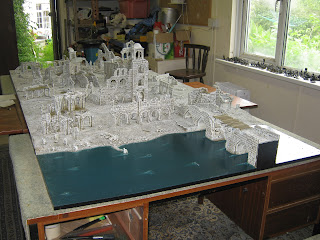When I last showed the board, it had just been covered with sand, the buildings had been glued into place, everything was ready to paint. Unfortunately, in the excitement, I forgot to take many photos of the painting stage. Know the entire board, sand included was painted the same way I showed you in the second stage post, where I had painted a building to see how the finished effect would look. The entire board took around 6 days to paint. The flat coat of brown took 4 alone. The river took no more than 10 minutes to paint, and was done using a mix of blues, greens black and bone. Here are some photographs of the various stages leading up to the board being finished, starting by showing the different stages of paint.
The board after the brown, leather and bone coats. Starting to look like a ruined city at last...
My first attempt at the river. Hated it, looked plastic, so I had to repaint it using more greens and less lightening around the shoreline.
River complete, as well as the white drybrushing finished for the ruins.
It was at this stage I taped the edges of the boards with black duct tape to give a professional finish.
The atmosphere of a ruined, half deserted city is captured from these angles...
Smaller details like reeds, dead grass and ladders were added after everything else was finished.It was around this stage I varnished the river to give it that glossy, reflective look. Took around 4 coats of wood varnish to get this effect. As they layers build up, it tends to clump a little around things like rocks and grass, which looks all the better. May add more coats as time goes on...
The all important orc bridge was made using the leftover scraps of balse wood layered over kebab skewers for rigidity. Painted up different colors to emphasize it's shambolic construction.
The main square, complete with statues, temple to the left and the four-storey city hall in the background.
Dead trees were scattered around the board where they might have been found to add another level of foliage to the scenery.
The final board in all its glory.
Just to show some detailing, and the fact that the GW ruins were used to some extent, though I personally prefer the home-made buildings better. More character.
Total time to complete:
4 months. 1 month over schedule.
Price rundown of third stage:
Scenic grasses £8The board after the brown, leather and bone coats. Starting to look like a ruined city at last...
My first attempt at the river. Hated it, looked plastic, so I had to repaint it using more greens and less lightening around the shoreline.
River complete, as well as the white drybrushing finished for the ruins.
It was at this stage I taped the edges of the boards with black duct tape to give a professional finish.
The atmosphere of a ruined, half deserted city is captured from these angles...
Smaller details like reeds, dead grass and ladders were added after everything else was finished.It was around this stage I varnished the river to give it that glossy, reflective look. Took around 4 coats of wood varnish to get this effect. As they layers build up, it tends to clump a little around things like rocks and grass, which looks all the better. May add more coats as time goes on...
The all important orc bridge was made using the leftover scraps of balse wood layered over kebab skewers for rigidity. Painted up different colors to emphasize it's shambolic construction.
The main square, complete with statues, temple to the left and the four-storey city hall in the background.
Dead trees were scattered around the board where they might have been found to add another level of foliage to the scenery.
The final board in all its glory.
Just to show some detailing, and the fact that the GW ruins were used to some extent, though I personally prefer the home-made buildings better. More character.
Total time to complete:
4 months. 1 month over schedule.
Price rundown of third stage:
Scenic trees £4
Wood varnish £6
Total £18
GRAND TOTAL £203... Not fot the faint-hearted!
GRAND TOTAL £203... Not fot the faint-hearted!










































